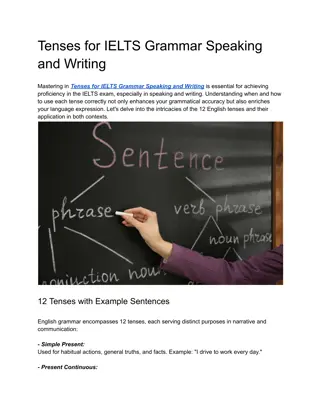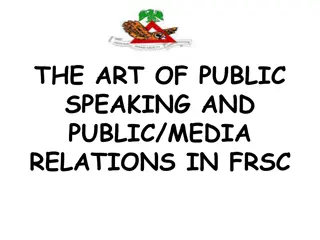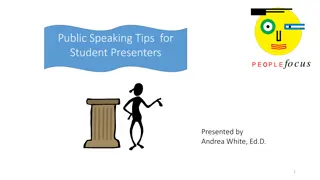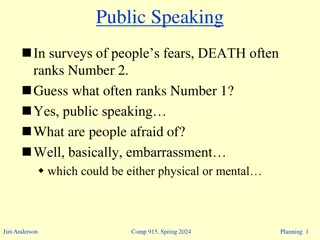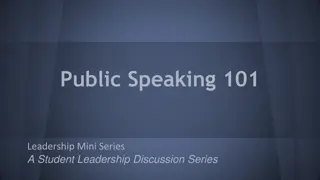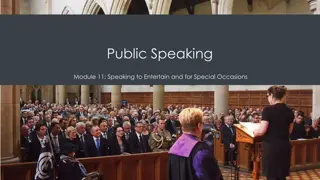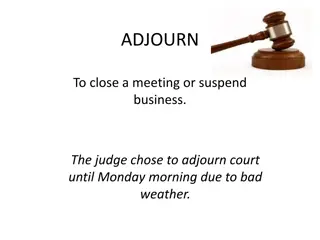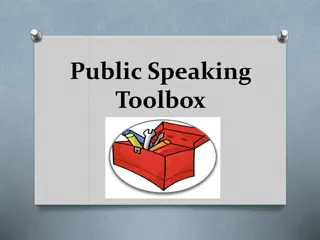Mastering Extemporaneous Speaking: 6 Steps for Success
Extemporaneous speaking is a well-prepared speech delivered without reading or memorization. Key steps include picking a topic, crafting a thesis, selecting supporting points, and practicing delivery. Participants have 30 minutes to prepare a seven-minute speech on national issues.
Uploaded on Oct 02, 2024 | 0 Views
Download Presentation

Please find below an Image/Link to download the presentation.
The content on the website is provided AS IS for your information and personal use only. It may not be sold, licensed, or shared on other websites without obtaining consent from the author. Download presentation by click this link. If you encounter any issues during the download, it is possible that the publisher has removed the file from their server.
E N D
Presentation Transcript
Extemporaneous Speaking By: Kelsey Phifer Climb the Mountain
What is Extemporaneous Speaking? An extemporaneous speech is a well- prepared speech that relies on research, clear organization, and practiced delivery. It is neither read nor memorized, so it is never delivered exactly the same way. Most extemporaneous speakers rely on notes of some sort, using index cards or technology
Follow these 6 steps to create an Extemporaneous Speech 1. Pick your topic 2. Answer the question and make a thesis statement. 3. Pick points that support your thesis. 4. Use your extemp tubs and other supports for your points. 5. Write your introduction and conclusion 6. Practice and then deliver your speech
Take Notes! We will go through each of the 6 steps in detail and practice each step. Make sure you are taking notes, because you will be giving an Extemp speech at the end of class. During your speech you may use a notecard or a sheet of paper. TIP: use short hand or abbreviations. Writing complete sentences takes too much time A competitor has 30 minutes to choose a topic and prepare a seven-minute speech.
Topics are posted on the wall. Bring your research materials to the competition. Step 1: Picking your Topic Find out when you speak (first, second, etc.) So, if you are the second speaker in your round, be watching for the posting of the topics for the second speaker. For EACH speaker, three topics are posted. These topics are almost always questions about national political, economic, and social issues.
1. What should the United States do about terrorism in the Middle East? Let s practice! 2. Who is the likely democratic candidate for the next Presidential election? PICK A TOPIC from the following choices: 3. Is our government doing enough to deal with viral diseases? You usually have thirty minutes to prepare for your speech. ***Choose the topic you feel most confident about shortly--within five minutes. Pick a topic that you know you have materials on (YOU MAY USE THE INTERNET), that you like to talk about, and that will interest your judge and demonstrate your expertise. Share with the class for practice.
Which topic did you pick? Please share with the class
An organized extemp tub helps you find articles after you have selected your topic it is ABSOLUTELY CRITICAL You need to develop a system for filing articles that enables you to easily locate items you need during prep time. What is an Extemp Tub ? Your extemp tub should have articles related to these three categories: 1. National 2. Political 3. Economic 4. social issues Note: Your extemp tub should be organized in categories and subcategories so that you can quickly search through them during your prep time at competition.
Step 2: Answer the question and make a thesis statement (Let s practice) Think about the topic you ve chosen and answer its question. *What do you think? Yes or no?* Write your answer down on a sheet of paper or note card as a complete sentence. Note: Consulting your extemp tubs, your prepared materials, can help you decide how to answer the question. ***For practice today, take a few minutes to answer your topic question, then share with the class your answer/thesis.***
Step 3: Pick points that support your thesis Take a moment and think up arguments that would support your thesis. Write the points down on a sheet of paper, leaving room after each one so that you can add supports. For practice today, share your 3 points with the class. Note: Consulting your extemp tubs, your prepared materials, can help you decide the points that you want to use. For example, you might come up with these points: 1. Clinton helped the economy and working Americans. 2. Clinton dealt with many personal attacks and scandals. 3. Overall, Clinton was a good president.
Please share your three points with the class
Step 4: Use your extemp tubs and other supports for your points. Look in your extemp tubs and write down supports: Short quotations, summaries of key points in your articles, stories and other key points of analysis that you have for your points. Have at least TWO SUPPORTS for each point if you possibly can and most extempers are expected to cite at least SIX SOURCES during your speech. Write down the supports. Let s Practice: Write down two supports with 3 sources (for today) and share with the class. (You may use the internet) NOTE: In competition, if the materials you have don t support the points you are making, then think about using different main points.
Please share your two supports, and three sources, with the class
Step 5: Write your introduction and conclusion The Introduction. 1. Start with an attention getter . Use a story, analogy or joke to captivate your audience. 2. In your introduction, state the question exactly as it is worded. Make it clear with your vocal intonation or by just stating the question for my speech is . . . 3. State your answer to the question; your thesis. Even if you don t have a clear cut yes or no answer to the question--state why you say yes but . . . or no but . . . (don t leave it vague with sometimes yes and sometimes no; you can leave it hanging but with a clear direction the answer is yes but there is a critical exception which I will explain in my third point. ) 4. Preview your main points. In my speech, I will discuss . . . and then state your two to four main points. The Conclusion. ***Let s Practice: Take a moment to write out your introduction and share it with the class.***
Please share your introduction with the class
Step 5: Writing the conclusion 1. Restate the question and your answer to it. 2. Summarize briefly how your points and supports demonstrate that your answer is correct. 3. Close by referring back to your introduction. Let s Practice: Take a moment to write your conclusion and share it with the class.
Step 6: Practice then deliver the speech Your preparation of the key points in your speech should take 20 or less minutes. In the last 10 minutes, you should walk to where you will present. Along the way, take time to practice the speech, preferably out loud. Go through the intro, the main points, the conclusion. Think about what you are saying. Make corrections. If you arrive at your room early before you are to speak, then take advantage of the chance to practice in the hallway or an empty room When the judge calls you, enter the room and deliver away with your speech. Let s Practice: Take some time to practice the materials you prepared out loud (mute your mics for your prep/practice). When you are ready, please present to the class. Remember this is practice, it s okay if it is not perfect now, just do your best
Lets put it all together! When you are ready, please present your speech to the class




